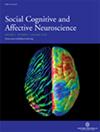Periaqueductal gray matter and medial prefrontal cortex reflect negative prediction errors during differential conditioning.
IF 3.1
2区 医学
Q2 NEUROSCIENCES
引用次数: 0
Abstract
Computational models of associative learning posit that negative prediction errors arising from the omission of aversive outcomes weaken aversive Pavlovian associations during differential conditioning and extinction. It is possible that negative prediction errors may underlie exaggerated conditioned responses to the CS- during differential conditioning and to the CS+ during extinction in patients with clinical anxiety disorders. Although previous research has demonstrated that manipulations of the periaqueductal gray matter (PAG) interfere with extinction learning in animals, the role of the PAG in processing negative prediction errors within the human brain is presently unclear. We set out to investigate how PAG BOLD responses and connectivity are impacted by negative prediction errors using ultra-high field (7T) functional MRI and hierarchical Bayesian analysis. During differential conditioning, negative prediction errors were associated with larger BOLD responses within the lateral and dorsolateral PAG and increased connectivity between the dorsolateral PAG and medial areas of Brodmann area 9. The relationship between negative prediction errors and BOLD responses during extinction was not significant. Collectively, these results shed light on the association between activity within the PAG and medial prefrontal cortex and the omission of aversive outcomes during Pavlovian learning.导水管周围灰质和内侧前额叶皮层反映了差异条件作用下的负面预测误差。
联想学习的计算模型假设,在差异条件作用和消退过程中,由于厌恶结果的遗漏而产生的负面预测误差(PEs)削弱了厌恶的巴甫洛夫联想。在临床焦虑障碍患者中,在差异条件反射过程中,对条件刺激未伴随不良结果(CS-)和在消退过程中对条件刺激最初伴随不良结果(CS+)的条件反应可能是负pe的基础。尽管先前的研究表明,对输水导管周围灰质(PAG)的操作会干扰动物的灭绝学习,但PAG在人脑中处理负PEs中的作用目前尚不清楚。我们利用超高场(7t)功能磁共振成像和分层贝叶斯分析研究了负PEs对PAG反应和连通性的影响。在差异条件下,负PEs与PAG外侧和背外侧的更大反应以及PAG背外侧与Brodmann区内侧区域之间的连通性增加有关。总的来说,这些结果揭示了PAG和内侧前额叶皮层的活动与巴甫洛夫学习过程中厌恶结果的遗漏之间的联系。
本文章由计算机程序翻译,如有差异,请以英文原文为准。
求助全文
约1分钟内获得全文
求助全文
来源期刊
CiteScore
6.80
自引率
4.80%
发文量
62
审稿时长
4-8 weeks
期刊介绍:
SCAN will consider research that uses neuroimaging (fMRI, MRI, PET, EEG, MEG), neuropsychological patient studies, animal lesion studies, single-cell recording, pharmacological perturbation, and transcranial magnetic stimulation. SCAN will also consider submissions that examine the mediational role of neural processes in linking social phenomena to physiological, neuroendocrine, immunological, developmental, and genetic processes. Additionally, SCAN will publish papers that address issues of mental and physical health as they relate to social and affective processes (e.g., autism, anxiety disorders, depression, stress, effects of child rearing) as long as cognitive neuroscience methods are used.

 求助内容:
求助内容: 应助结果提醒方式:
应助结果提醒方式:


